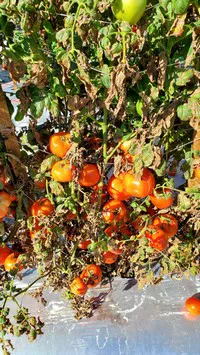Agdia announces the commercialisation of a rapid diagnostic test for detection of several phytopathogenic members of the Xanthomonas genus on their ImmunoStrip® platform.
Xanthomonas is a large genus of gram-negative bacteria containing numerous phytopathogenic species and pathovars within species. These pathogens cause widespread outbreaks among many economically important hosts, and diseases include citrus canker, fruit and leaf spot on pepper and tomato, black rot of crucifers, and blight on geranium.


 Members of Xanthomonas display a great degree of host plant specificity and tissue specificity, invading either the mesophyll tissue (cankers and leaf spots) or the vascular tissue (blights and wilts). Many of these diseases are responsible for devastating crop losses throughout the world, affecting both crop productivity and quality if unchecked. Therefore, many species of Xanthomonas are considered organisms of quarantine status by the European and Mediterranean Plant Protection Organization (EPPO).
Members of Xanthomonas display a great degree of host plant specificity and tissue specificity, invading either the mesophyll tissue (cankers and leaf spots) or the vascular tissue (blights and wilts). Many of these diseases are responsible for devastating crop losses throughout the world, affecting both crop productivity and quality if unchecked. Therefore, many species of Xanthomonas are considered organisms of quarantine status by the European and Mediterranean Plant Protection Organization (EPPO).
Outbreaks of disease caused by Xanthomonas can occur throughout the season. Nevertheless, the proliferation of inoculum (bacterial cells) and subsequent dissemination are dependent on local climatic conditions. Colony growth is optimal during periods of warm, wet weather. Xanthomonas forms mucilaginous colonies, which are suspended in water and spread locally in droplets via wind, splashing rain and overhead irrigation. Furthermore, human activities such as picking fruit and pruning can exacerbate spread within fields, greenhouses and orchards. Long-distance dispersal is most common via movement of infected budwood, cuttings, seedlings and seed.


Bacterial cells enter leaves, fruit and stems through natural openings and injured tissue. Thereafter, a wide variety of symptoms are observed, depending on the specific pathosystem. Infected pepper and tomato plants are known to exhibit lesions on foliage, stem (figure 1.) and unripe and ripe fruit (figure 2.). Lesions can render fruit unmarketable, while severe foliar infections can cause defoliation, leading to sunscald of fruit and overall plant deterioration (figure 3.). Symptomology is like that on pepper and tomato, including corky lesions on fruit, leaves and woody stems. Citrus fruit exhibiting cankers are unsalable for fresh market and can drop prematurely under high disease pressure. Bacterial spot on peppers and tomatoes is caused by four species of Xanthomonas: X. euvesicatoria, X. gardneri, X. perforans and X. vesicatoria. Citrus canker, caused by X. axonopodis pv. citri, is one of the most pressing diseases among citrus spp. worldwide.
Xanthomonas campestris pv. campestris, the causal agent of black rot of crucifers, can cause severe disease in several species of Brassicaceae, including broccoli, Brussels sprouts, collard, cabbage, cauliflower, kohlrabi, rutabaga and turnip. Crop losses of 50% are not uncommon under conditions conducive to rapid spread of the pathogen. Symptoms include wilting and collapse of seedlings, necrosis at leaf margins (figure 4.) and interveinal, V-shaped lesions on mature plants (figure 5.). Bacterial blight on geranium is caused by Xanthomonas hortorum pv. pelargonii. This disease is specific to and one of the most important diseases of Geranium and Pelargonium. Symptoms vary depending on species and typically include water-soaked lesions, progressing to form larger, V-shaped lesions, similar to those observed in black rot infections. Bacteria often invade the vascular system and cause wilting and eventual plant death.
Agdia’s new Xanthomonas ImmunoStrip® was screened against a diverse panel of species and pathovars within the genus, detecting 100% of true positives, including X. euvesicatoria, X. gardneri, X. perforans, X. vesicatoria, X. axonopodis pv. citri, Xanthomonas campestris pv. campestris, Xanthomonas hortorum pv. pelargonii, X. oryzae pv. oryzae and X. fragrariae.
Agdia states no cross-reactivity was observed for several potential cross-reactors, including Acidovorax spp., Clavibacter spp., Erwinia spp., Pseudomonas spp., and Xylella fastidiosa. This assay was designed to be used on leaf, stem, seed, root and pure culture.
"Our ImmunoStrip® platform provides end-users with unparalleled utility," the team says. "Samples can be tested in the field or lab by those having no previous diagnostic experience, and results are visualized within no more than 30 minutes. Furthermore, this product includes everything necessary to perform a test and does not require special equipment."
Test protocol is simple and includes 1) Sample collection and extraction in Agdia buffer bags, 2) Exposing the ImmunoStrip® to the sample extract, and 3) Allowing results to develop. Test results are visualized as a single control line or a control and test line for negative or positive results, respectively. The introduction of Agdia’s Xanthomonas ImmunoStrip® expands their catalog to 44 plant pathogen products on this platform. High levels of market demand for field-deployable, plant pathogen detection products have driven this output, and Agdia maintains they will continue to expand their product catalog.
The Xanthomonas ImmunoStrip® is sold in kits of 5 or 25 strips, and kits include everything necessary to perform a test. Agdia provides a one-year warranty on purchased kits. A diagnostic assay for the detection of the Xanthomonas genus is also available in an enzyme linked immunosorbent assay (ELISA) format.
For more information:
Agd ia Inc.
ia Inc.
52642 County Road 1
Elkhart, IN 46514
phone 1-574-264-2615
fax 1-574-264-2153
info@agdia.com
www.agdia.com
